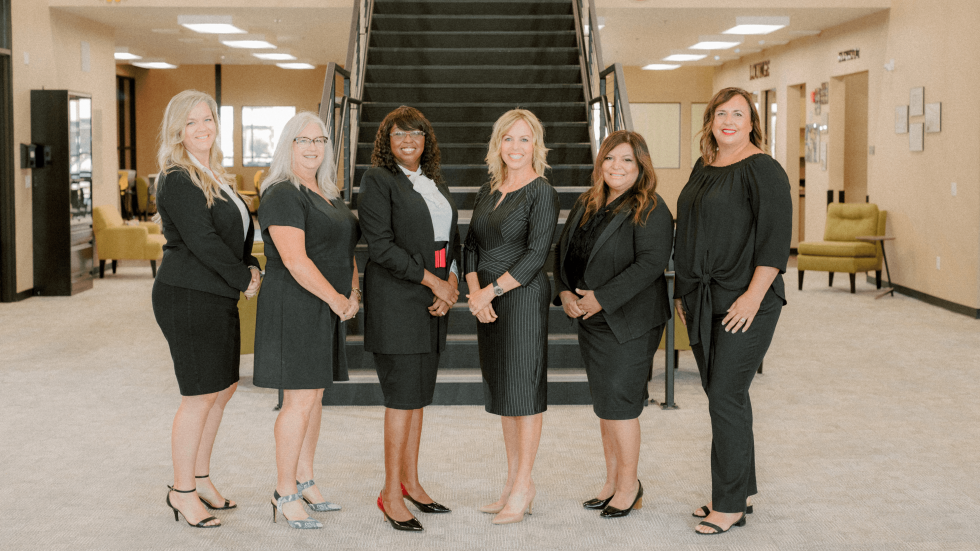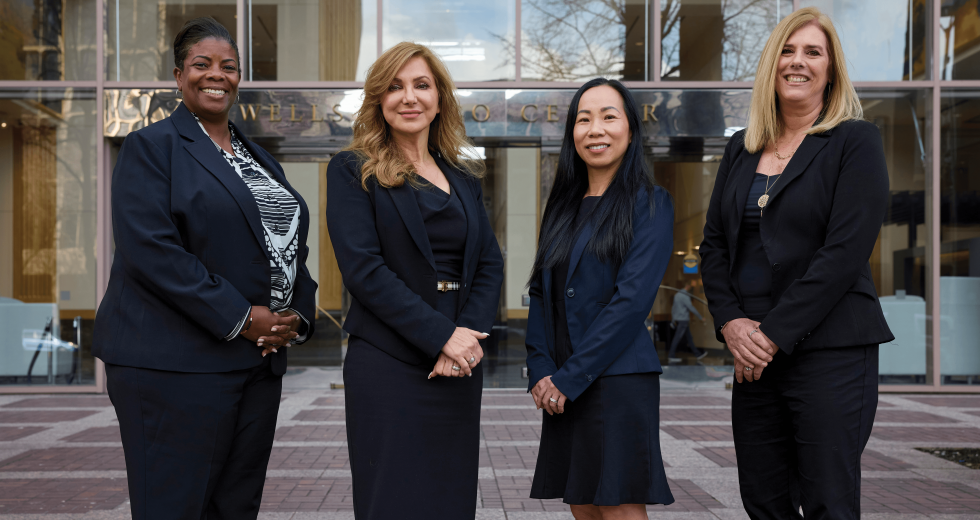What makes a good leader?
Empathy, authenticity, hard work. The ability to build relationships and the courage to take wise risks.
These are some of the characteristics described by local leaders in transportation, education and news media when discussing strong leadership. And they should know. These women’s paths have led them to positions of influence in their fields, and in some cases, they’ve made history in their roles.
The routes to success at Caltrans
Dara Wheeler doesn’t just want to make transportation better for Californians. She and her Caltrans colleagues want to serve as a model for transportation departments nationwide.
Among the oldest state departments, Caltrans is responsible for more than 50,000 miles of highways and freeways, as well as airports and railways. Wheeler, who manages the division of Research, Innovation and System Information, says her division is one of “ideas and solutions,” typically rooted in artificial intelligence, Geospatial Information Systems (GIS) data and research collaborations with universities, including 270 research projects underway.
“We’re kind of like the think tank and the keeper of data solutions all rolled into one area,” says Wheeler.
To represent Caltrans’ work nationally, she’s active on committees of the American Association of State Highway Transportation Officials, the national Transportation Research Board and other industry organizations. Wheeler is one of several women on the executive team in not only the typically male-dominated space of transportation, but within the top ranks of expertise at Caltrans.
When Donna Berry graduated from UC Davis in 1992 with her civil engineering degree, there were few women in the field. Her first job as a project engineer with Caltrans springboarded her career, and as part of the rotation program she worked in various divisions, giving her a fuller picture of the department before climbing its leadership ladder.
But she stepped away from Caltrans after she had her second son, a difficult decision not uncommon for moms with young kids at home.
“I couldn’t be all that I could be in both places,” she says; she didn’t want to prioritize a demanding work schedule at that time. “I had to leave in order to do what I felt was important, which was my family.”
With the support of her husband, she left Caltrans for about four years. It was a risk that paid off. “Being able to bet on myself … it made me stronger,” she says.
In 2022, Berry was promoted to chief engineer and deputy director for project delivery for Caltrans. In this dual role, she oversees seven divisions of Caltrans, including design, environmental and broadband, spearheads policy and delivery of transportation projects, and directs over 11,000 employees total.
Like Wheeler, Berry is active in national professional organizations to heighten the profile of Caltrans, including the National Society of Black Engineers, where she encourages students to pursue Science, Technology, Engineering and Math, or STEM, careers.
“In all my roles, I seek to be an advocate for women in leadership roles and provide support for diversity and inclusion in the government,” she says.
This effort to diversify incoming Caltrans employees is also championed by Luc Sou, the division chief of project and business management. Hired in 2018, hers was an indirect route into the field. With plans to be a teacher, she majored in human development at UC Davis before finding her passion for project management through a certification program at Sacramento State. Today, she’s created partnerships with universities to get Caltrans on the radar of diverse job-seekers.
Sou says she’s looked to her colleagues like Berry, Wheeler and Chief Information Officer Marcie Kahbody for inspiration of strong leadership. (See the Women in Leadership story for a separate profile on Kahbody.)
“The ability to lead with authenticity, empathy and adaptability — I think those are key attributes,” she says. “All these great leaders who not only lead by being their authentic self, but encourage each and every one of us to bring their whole self.”
Homegrown leadership
Terrell Martinez was born and raised in south Stockton, and at the young age of 11, she helped her grandfather with his checkbook — helping spark an interest in finances.
The words “Educate, innovate, inspire” welcome visitors to the main building of the San Joaquin County Office of Education, about a mile away from where Martinez grew up.
Martinez credits her teachers at Franklin High School in Stockton with encouraging her to pursue a career in accounting. This year will mark her 25th year with the office, where she started as a payroll technician. Today, she’s the deputy superintendent of business services for the San Joaquin County Office of Education, responsible for a nearly $700 million budget, and the first African American member of the superintendent’s cabinet in the office’s history.
Each of California’s 58 counties have a county office of education to provide fiscal oversight and support locally. In San Joaquin County, this encompasses 14 school districts and charter schools with roughly 152,000 students.
Martinez is one of the six women on the county superintendent of schools cabinet, an eight-member team of executive staff who advise Superintendent of Schools Troy Brown. Other members include Christina Torres-Peters, who grew up in the Stockton-Manteca region and is the first Latina in the cabinet’s history. Her route to her position as chief human resources officer of the county office was through the San Joaquin County Sheriff’s Office, where she started her career documenting and translating statements.
“That opportunity really segued me into all kinds of areas, one of those being Internal Affairs, which is essentially HR,” she says. “I had a lot of experience, not knowing then that it would turn into this career.”
With her career spanning law enforcement, education and the private sector, she’s found her home with the county office of education. What excites her most is her department’s growth — it just hired its first-ever recruitment and retention coordinator.
For Brandie Brunni, associate superintendent of student programs and services, the growth she’s seen since starting as a speech pathologist in 1998 is a point of pride for her, too. The office’s offerings of preschool autism programs grew from two classes to 30 at its height, and now they’re rolling back that number — with good reason.
“Now we’re training our districts to provide those services,” says Brunni, whose focus has been on special education. “We’re passing the baton for our districts to provide those services and provide them really well.”
Members of this cabinet have also worked to build community among female professionals outside of education. In 2018, Janine Kaeslin, associate superintendent who represents Student Programs and Services, and Jane Chamberlain, assistant superintendent of Education Services, founded what would become Women Together International — a group for women across professions.
From left to right, Melanie Greene, assistant superintendent,
County Operated Schools and Programs; Jane Chamberlain, assistant
superintendent, Educational Services; Terrell Martinez, deputy
superintendent, Business Services; Janine Kaeslin, associate
superintendent, Student Programs and Services; Christina
Torres-Peters, chief human resources officer; and Brandie Brunni,
assistant superintendent, Special Education and SELPA. (Courtesy
of San Joaquin County Board of Education)

The organization hosts free virtual conferences each year, with guest speakers presenting on topics like women leading in male-dominated industries, breaking internal barriers and shattering the glass ceiling that can hold women back from leadership roles. Martinez and cabinet member Melanie Greene are also involved with the organization as committee members.
Still, the successes of the cabinet are closer to home. For Associate Superintendent Kaeslin, it includes partnering with Martinez to establish a National Guard-affiliated Discovery Challenge Academy, which is under the County Operated Schools and Programs. Assistant Superintendent Greene heads that department, which serves students who are in foster care or homeless, have been expelled, or are English language learners, and connects young adults to work opportunities.
“I like to say that if someone needs a second chance they can come to COSP and get it,” says Greene. “We have a program for you. And if we don’t have it for you, we’re going to create it.”
Associate Superintendent Kaeslin says the office’s motto — educate, innovate, inspire — drives their work daily.
“It doesn’t matter what department you go to here at the county office of education, you will feel it,” she says. “You won’t just see it in action, you’ll feel it.”
Leading the local news
For the first time in recent memory, several major news outlets in the Sacramento region are headed by women. As in many industries, the tops of news organizations have traditionally been occupied by men; but with this shift locally the women who lead major media outlets bring with them the wisdom of their mentors — and lessons for the future.
When Colleen McCain Nelson had her first leadership role in news, she’d often ask herself: “What would Keven do?”
Keven Ann Willey, her previous opinion editor at the Dallas Morning News, had modeled what it meant “to be an effective and empathetic leader,” McCain Nelson says, and she knew that resulted in great work. On Willey’s team, McCain Nelson and her colleagues won the Pulitzer Prize for a series of editorials investigating the economic divide between northern and southern Dallas. She knew the leadership qualities of being a good listener and trusting in your team were valuable.
The four TV news stations and the main newspaper in Sacramento
are all led by women. From left to right, Colleen McCain Nelson,
executive editor, the Sacramento Bee; Cathy Gunther, vice
president and general manager, Fox 40; Ariel Roblin, president
and general manager, KCRA and KQCA; Risa Omega, president and
general manager, ABC 10; and Deborah Collura, president and
general manager, KOVR13 and KMAX31.

“As a leader, you should prioritize listening more and talking less,” she says. “I want everyone in the newsroom to feel empowered to contribute ideas and to help set our course.”
In 2021, McCain Nelson was hired as the executive editor of The Sacramento Bee and regional editor for California with McClatchy, the Bee’s parent company. She was one of a handful of women in the journalism field who took the helm at prominent local outlets in recent years, including Deborah Collura, president and general manager of KOVR13 and KMAX31; Ariel Roblin, president and general manager of KCRA and KQCA; and Cathy Gunther, who started as vice president and general manager of Nexstar Media Group’s local affiliate, FOX40, last September. They join leaders Risa Omega of ABC10 and Sara McClure of iHeartMedia in shaping a local media landscape led by women.
Her counterpart at the region’s CBS affiliate agrees that being a good listener is a top quality for anyone working in journalism. “Whether you’re on the street or in a leadership position, you have to be a great listener,” says Collura.
When Ariel Roblin came to head KCRA in 2020, she brought along a tradition started when she was managing a fellow Hearst Television station in Omaha, Nebraska: televised editorials from her directly. In Sacramento, her topics have included preventing wildfires, guns and the importance of political debates.
“We have this really unique position in a community where we hear both sides all the time,” Roblin says. “There’s a lot of great information you can get from being inside of a television station and having viewers connect with you on a regular basis.”
Collura, who started her career hand-delivering ads for her hometown Rockford Register Star as a high school senior, says being a woman in news means having a perspective that’s not always “welcomed or appreciated.” And for women facing those circumstances, she has advice:
“If it doesn’t come so easily, don’t let it take you off course,” Collura says. “You have to be resilient; you have to be persistent.”
Get all the stories in our annual salute to women in leadership delivered to your inbox: Subscribe to the Comstock’s newsletter today.
Recommended For You

Women in Leadership: Carmen Marsh
Our annual salute to women at the top of their field
Carmen Marsh can say something with confidence that many can’t: She always enjoys her jobs. Twenty-five years ago, she found her passion for technology and has stuck with the profession ever since.

Women in Leadership: Marcie Kahbody
Our annual salute to women at the top of their field
Ask Marcie Kahbody about the most important lesson she has learned in her successful three-decade career in IT, and she’ll answer emphatically: “Embracing change.”

Women in Leadership: Dawnté Early
Our annual salute to women at the top of their field
“I did not get here by myself,” says Dr. Dawnté Early about her journey to her two primary leadership positions in the Sacramento area: West Sacramento City Council member and president and CEO of United Way California Capital Region. “It’s full circle.”

Women in Leadership: Maggie Bender-Johnson
Our annual salute to women at the top of their field
Maggie Bender-Johnson, the new CEO of family-run Bender Insurance Solutions, has some big, hairy, audacious goals (BHAGs).

Women in Leadership: Cheyanne Anquoe
Our annual salute to women at the top of their field
Cheyanne Anquoe is chief operating officer at Arnold Law Firm, one of the top personal injury law firms in the Capital Region.

From Steno Pads to C-Suites: We’ve Come a Long Way
In light of our Women in Leadership issue, Comstock’s President and Publisher Winnie Comstock-Carlson reflects on how far we’ve come.




